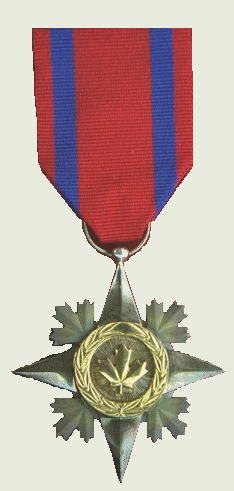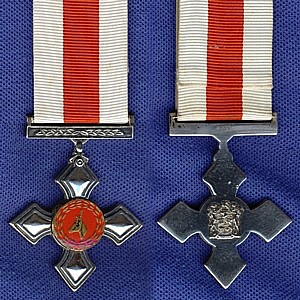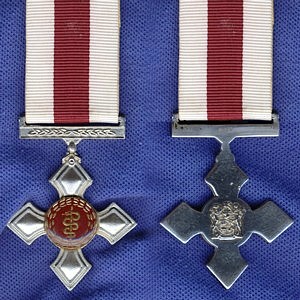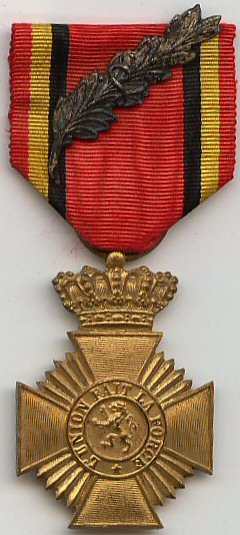
An oak leaf cluster is a ribbon device to denote preceding decorations and awards consisting of a miniature bronze or silver twig of four oak leaves with three acorns on the stem. It is authorized by the United States Armed Forces for a specific set of decorations and awards of the Department of Defense, Department of the Army, and Department of the Air Force.

The Military Medal (MM) was a military decoration awarded to personnel of the British Army and other arms of the armed forces, and to personnel of other Commonwealth countries, below commissioned rank, for bravery in battle on land. The award was established in 1916, with retrospective application to 1914, and was awarded to other ranks for "acts of gallantry and devotion to duty under fire". The award was discontinued in 1993, when it was replaced by the Military Cross, which was extended to all ranks, while other Commonwealth nations instituted their own award systems in the post war period.

The Butler Medal, also known as the Colored Troops Medal, was a military decoration of a unit of the United States Army which was issued in 1865. The medal was commissioned by Major General Benjamin Butler and was intended to recognize meritorious or heroic acts of bravery performed by African American soldiers at the Battle of Chaffin's Farm and New Market Heights. Fourteen African Americans had earned the Medal of Honor in that engagement, but Butler wished to further recognize his African American troops involved in the battle, and he paid for the Butler Medals out of his personal funds.

The Royal Red Cross (RRC) is a military decoration awarded in the United Kingdom and Commonwealth for exceptional services in military nursing.

The Order of Alexander Nevsky is an order of merit of the Russian Federation named in honour of saint Alexander Nevsky (1220–1263) and bestowed to civil servants for twenty years or more of highly meritorious service. It was originally established by the Soviet Union as a military honour during World War II, more precisely by Decree of the Presidium of the Supreme Soviet of the USSR of July 29, 1942. Its statute was amended by Decree of the Presidium of the Supreme Soviet of the USSR of February 26, 1947. It bears a similar name to the Order of Saint Alexander Nevsky which had been established by Empress Catherine I of Russia in 1725, and continued to be bestowed by the heads of the House of Romanov after the 1917 Russian Revolution. The Order of Alexander Nevsky was reinstated by the Soviet Union, minus the words "Imperial" and "Saint", for award to officers of the army for personal courage and resolute leadership. The Order was retained by the new Russian Federation following the dissolution of the USSR by Decision of the Supreme Soviet of the Russian Federation 2557-I of March 20, 1992 but was never awarded. The September 7, 2010 Decree №1099 of the President of the Russian Federation redesigned the badge of the Order closer to pre-1917 imperial model and amended the statute of the Order making it a purely civilian award.

The Order of Karađorđe's Star is Serbia's highest civilian and military decoration. It originated in the Kingdom of Serbia, and was initially awarded exclusively to Serbian citizens in return for services rendered to the Serbian monarchy, the Serb people and the Serbian state, though it is now bestowed upon Serbs and non-Serbs alike. During the Balkan Wars and World War I, the Order was mostly awarded for acts of bravery on the battlefield. The post-war Kingdom of Yugoslavia retained the Order, and it was awarded by the Yugoslav government-in-exile until the end of World War II, in some cases to individuals who collaborated with the Axis powers. Following the war, the monarchy was outlawed and a communist government came to power. Along with other monarchist symbols, the Order was suppressed during the administration of Josip Broz Tito, and replaced with communist decorations such as the Order of the People's Hero. During the Cold War, it had been awarded by the Karađorđević family in exile.

The Louw Wepener Decoration, post-nominal letters LWD, is a military decoration for bravery which was instituted by the Union of South Africa in 1952. It was awarded to members of the South African Defence Force for acts of the most conspicuous courage or greatest heroism. The decoration was discontinued on 1 July 1975, when a new set of decorations and medals was instituted.

The Military Merit Medal was a military decoration of the Empire of Austria-Hungary. It was founded by Emperor Franz Joseph I on March 12, 1890. The Military Merit Medal is often referred to as the "Signum Laudis" after the inscription on the reverse of the medal.

The Star of Courage is a decoration that is the second-highest award for bravery within the Canadian system of honours, and one of the three Canadian Bravery Decorations awarded by the Canadian monarch, generally through his or her viceroy-in-Council. Created in 1972, it is presented to both living and deceased individuals deemed to have performed "acts of conspicuous courage in circumstances of great peril". Recipients are allowed to use post-nominal letters – for Anglophones SC, and for Francophones ÉC.

The Sea Gallantry Medal (SGM), is a United Kingdom award for civil gallantry at sea.

The Honour medal for firefighters is a state decoration of France bestowed by the Ministry of the Interior to members of the French Fire Service.

The Medal for Bravery or Courage, commonly known as the Medal of Miloš Obilić, is a state decoration awarded by the Republic of Serbia, and before that by the Kingdom of Serbia and the Kingdom of Yugoslavia, for heroic acts.

The Medal of Zhukov is a state award of the Russian Federation initially awarded to veterans of the Great Patriotic War but now awarded to serving members of the Armed Forces of the Russian Federation. It is named in honour of Marshal of the Soviet Union Georgy Zhukov, the most decorated general in the history of the Soviet Union.
The Croix de guerre (French) or Oorlogskruis (Dutch) is a military decoration of the Kingdom of Belgium established by royal decree on 25 October 1915. It was primarily awarded for bravery or other military virtue on the battlefield. The award was reestablished on 20 July 1940 by the Belgian government in exile for recognition of bravery and military virtue during World War II. The post-1940 decoration could also be awarded to units that were cited. The decoration was again reestablished by royal decree on 3 April 1954 for award during future conflicts.

The Medal "For Courage" or Medal "For Valour" is a state decoration of the Russian Federation that was retained from the Soviet awards system following the dissolution of the USSR.

The Army Cross, post-nominal letters CM, is a military decoration which was instituted by the Republic of South Africa in 1987. It was awarded to members of the South African Army for bravery. The Army Cross was discontinued in 2003, but backdated awards can still be made for acts of bravery during this period.

The Medical Service Cross, post-nominal letters CC, is a military decoration which was instituted by the Republic of South Africa in 1987. It was awarded to members of the South African Medical Service for bravery. The Medical Service Cross was discontinued in 2003, but backdated awards can still be made for acts of bravery during this period.

The Gallantry Cross, Silver, post-nominal letters GCS, was instituted by the President of the Republic of Venda in 1985, for award to all ranks for courage or bravery or valour beyond the normal call of duty.

The Woltemade Cross for Bravery, Gold, post-nominal letters WD, is the senior of two classes of a South African civil decoration for acts of bravery. It replaced the Union of South Africa King's Medal for Bravery, Gold, Union of South Africa Queen's Medal for Bravery, Gold and Woltemade Decoration for Bravery, Gold, all of which ranked on par with each other and the award of which had been discontinued in 1952, 1961 and 1988 respectively.

The Military Decoration for Exceptional Service or Acts of Courage or Devotion is awarded to personnel of the Belgian Armed Forces for either displayed herorism or for display of extraordinary devotion to duty. In history, sometimes it is referred to as an 'Article 4' award, as originally, the medal was created as a variation of the military decoration for long service. However, nowadays, both medals are distinct awards, albeit still having the same guilt cross.



















